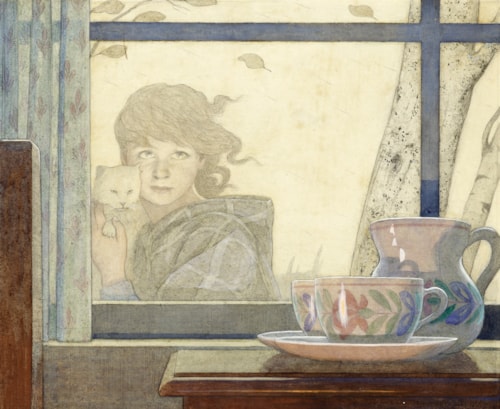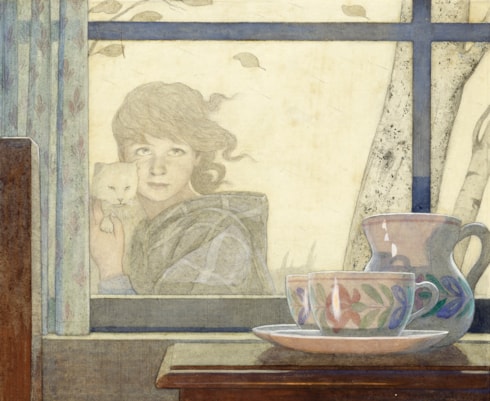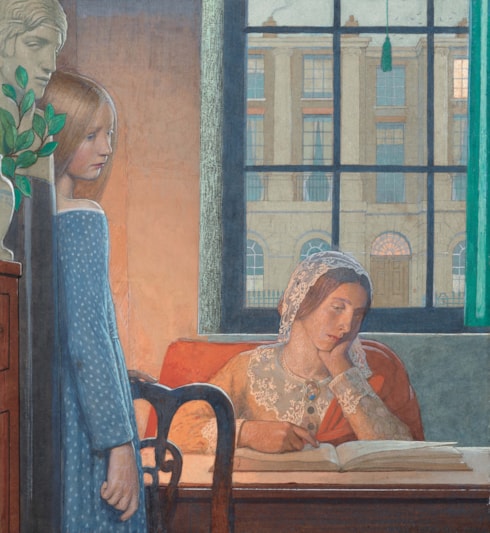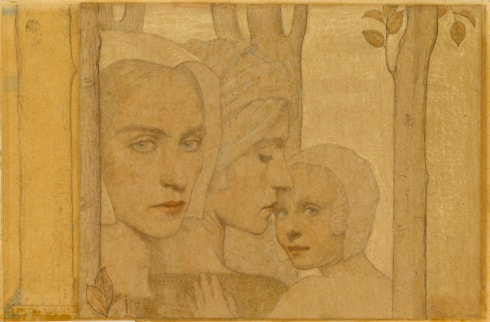
Frederick CAYLEY ROBINSON
Brentford-on-Thames 1862 - London 1927
Biography
Despite being arguably one of the most interesting and original artists working in England in the first quarter of the 20th century, Frederick Cayley Robinson remains a relatively obscure figure to this day. His work has not been the subject of a monograph, nor has there been any major retrospective exhibition of his paintings since 1977; indeed, during his lifetime he was only accorded three one-man exhibitions. Cayley Robinson studied at St. John’s Wood School of Art between 1883 and 1885, and thereafter at the Royal Academy Schools. He completed his studies at the Académie Julian in Paris, between 1891 and 1894. There he came into contact with the work of Pierre Puvis de Chavannes and the Nabis painters, who were to have a strong influence on his style, although he was also much inspired by the work of Sir Edward Burne-Jones and the painters of the early Renaissance in Italy. As early as 1896 the critic Alfred Lys Baldry noted of the young Cayley Robinson that ‘He has already established himself as an artist who occupies a place by himself, and he is conspicuous because he fills that place with real distinction. If he goes on as he has begun he can hardly fail to make his mark on the art-record of our times.’
Much of the early part of Cayley Robinson’s career was spent abroad. He lived for several years in Florence, where he studied the art of Giotto, Mantegna and Michelangelo, and took up the practice of painting in tempera. After a period of four years in Paris, he settled in Cornwall in 1906. He began to exhibit his watercolours in 1911 at the Royal Society of Painters in Water Colours, and continued to send two or three works to each of the Society’s annual exhibitions until 1926. Much of Cayley Robinson’s work is characterized by a sense of stillness and meditative calm, and this is perhaps especially true of his exhibition watercolours. Indeed, as James Greig noted in an appreciation of Cayley Robinson’s work in watercolour, published shortly after the artist’s death, ‘neither medium nor method counts in any great measure for the attractiveness of Cayley Robinson’s oeuvre. Its influence is exercised mainly through spiritual emotion conveyed in rhythmic movement and tender tones of alluring beauty. The rhythm is always controlled within a well thought out design, but it is the elusiveness of the inward motive of his pictures that gives them their indefinable charm.’
Cayley Robinson exhibited regularly at the Old Water-Colour Society, The Royal Society of British Artists and the Glasgow Institute of the Fine Arts. He also began receiving commissions for costume and set designs for theatrical productions, most notably for a staging of Maurice Maeterlinck’s The Blue Bird at the Haymarket Theatre in 1909; a work that served to cement his reputation as what one recent scholar has described as ‘a sensitive painter of the child’s-eye view’. (The artist also provided the drawings for an illustrated edition of The Blue Bird, published in 1911; the drawings were exhibited at the Leicester Galleries in London the same year.)
Apart from his easel paintings, Cayley Robinson was highly regarded as a mural painter. Perhaps his finest works in this field are a series of four enormous oil paintings on canvas collectively known as The Acts of Mercy, painted for the entrance hall of Middlesex Hospital in London. Commissioned from the artist in 1910 and painted between 1915 and 1920, the paintings remained in situ until the Hospital was demolished in 2008, and were acquired the following year by the Wellcome Library in London. In 1914 Cayley Robinson also won a commission to paint a mural of The Coming of Saint Patrick to Ireland for the Dublin Art Gallery. By this time he had settled in London, established in a block of studios in Lansdowne Road which also housed the artists Charles Ricketts and Charles Shannon, Glyn Philpot and James Pryde. He lived there from 1914 until his death, although he spent three months every year until 1924 in Glasgow, as Professor of Figure Composition and Drawing at the Glasgow School of Art. Elected a member of the Royal Watercolour Society in 1919 and an Associate of the Royal Academy in 1921, he was also a member of the New English Art Club.




